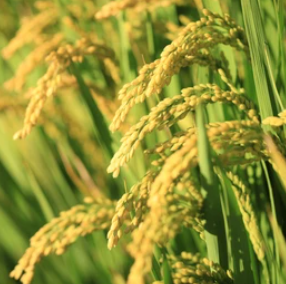Information report for sh4;SHA1
Gene Details
|

|
Functional Descriptions
- Here we show that the seed shattering is controlled by a single dominant gene, Shattering1 (SHA1), encoding a member of the trihelix family of plant-specific transcription factors.
- Our results demonstrate that the g237t mutation in SHA1 accounts for the elimination of seed shattering, and that all the domesticated rice cultivars harbor the mutant SHA1 gene and therefore have lost the ability to shed their seeds at maturity.
- Genetic analyses revealed that the expression of SHAT1 in AZ was positively regulated by the trihelix transcription factor sh4.
- The sh4 phylogeny together with the neutrality tests and coalescent simulations suggested that sh4 had a single origin and was fixed by artificial selection during the domestication of rice.
- sh4 (for grain shattering quantitative trait locus on chromosome 4) and qSH1 (for quantitative trait locus of seed shattering on chromosome 1) genes have been identified as required for reduced seed shattering during rice (Oryza sativa) domestication.
- We also identified a frameshift mutant of sh4 that completely eliminated AZs and showed nonshattering.
- Here, we studied nucleotide variation at the shattering loci, sh4 and qSH1, for cultivated rice, Oryza sativa ssp.
- The nonshattering sh4 allele was fixed in all rice cultivars, with levels of sequence polymorphism significantly reduced in both indica and japonica cultivars relative to the wild progenitors.
- The slow fixation of the nonshattering phenotype observed at the archeological sites might be a result of relatively weak selection on mutations other than sh4 in early rice cultivation.
- We assessed allelic identity and diversity at the major shattering locus, sh4, in weedy rice; we find that all cultivated and weedy rice, regardless of population, share similar haplotypes at sh4, and all contain a single derived mutation associated with decreased seed shattering.
- Our results suggest a genetic model in which the persistent and concentrated expression of active SHAT1 and sh4 in the AZ during early spikelet developmental stages is required for conferring AZ identification.
- The combination of a shared cultivar sh4 allele and a highly shattering phenotype, suggests that U.
- Our findings suggest that sh4 may have additional functions in the growth and development of rice, apart from its major role in seed shattering.
- Rice seed shattering is an important domestication syndrome encoded by a gene named as sh4.
- Interestingly, GL4 also controls the seed shattering phenotype like its orthologue sh4 gene in Asian rice.
- Comparative analysis at sh4 showed that all the accessions containing ancestral haplotype, including 78 wild relatives of rice and 8 African cultivated rice, had the shattering phenotype, whereas all the accessions with either of the homozygous domestic haplotypes at one of the two sites, including 17 wild relatives of rice, 111 African cultivated rice and 65 Asian cultivated rice, showed the non-shattering phenotype.
- MutMap cloning revealed that SG5 encodes a Myb-like transcription factor.
- Histochemical observation and gene expression analysis indicated that SG5 regulates spikelet hull development by mediating cell expansion.
- The effect of pyramiding SG5 and GS3 suggests that SG5 and GS3 regulate grain length independently.
- The results of our study show that the missense mutation in SG5 is essential for the molecular function of SG5 and SG5 is involved in regulating cell expansion and expression of grain-shape-related genes to regulate grain length.
- In addition, the SG5 protein is found in the nucleus and does not affect subcellular localization.
- SG5 is mainly expressed in young panicles and hulls.
Functional Keywords
- seed , transcription-factor , domestication , shattering , grain , spikelet , growth , development , seed-shattering , grain-length , nucleus , cell-expansion , young-panicles
Literature and News
- Origin of seed shattering in rice (Oryza sativa L.) . DOI: 10.1007/s00425-006-0460-4 ; PMID: 17216230
- Molecular evolution of shattering loci in U.S. weedy rice . DOI: 10.1111/j.1365-294X.2010.04708.x ; PMID: 20584132
- Genetic analysis of rice domestication syndrome with the wild annual species, Oryza nivara . DOI: 10.1111/j.1469-8137.2005.01647.x ; PMID: 16539615
- Selection on grain shattering genes and rates of rice domestication . DOI: 10.1111/j.1469-8137.2009.02984.x ; PMID: 19674325
- Genetic control of seed shattering in rice by the APETALA2 transcription factor shattering abortion1 . DOI: 10.1105/tpc.111.094383 ; PMID: 22408071
- Rice domestication by reducing shattering . DOI: 10.1126/science.1123604 ; PMID: 16527928
- Identification of genetic factors controlling domestication-related traits of rice using an F2 population of a cross between Oryza sativa and O. rufipogon . DOI: 10.1007/s001220051064
- Multiple tissue-specific expression of rice seed-shattering gene SH4 regulated by its promoter pSH4 . DOI: 10.1186/s12284-015-0047-4 ; PMID: 25844117
- A single-nucleotide polymorphism causes smaller grain size and loss of seed shattering during African rice domestication . DOI: 10.1038/nplants.2017.64 ; PMID: 28481332
- Two SNP Mutations Turned off Seed Shattering in Rice . DOI: 10.3390/plants8110475 ; PMID: 31698744
- Short grain 5 controls grain length in rice by regulating cell expansion . DOI: 10.1016/j.plantsci.2022.111412 ; PMID: 35961516
Gene Resources
- UniProt: Q7XR48
- EMBL: AB920921, AP014960, GU220965
- AlphaFoldDB: Q7XR48
- EnsemblPlants: Os04t0670900-01
- Gramene: Os04t0670900-01
- KEGG: osa:9266435
- Orthologous matrix: WTMERHE
- InterPro: IPR001005, IPR044822
- PANTHER: PTHR33492, PTHR33492:SF11
- PROSITE: PS50090
- Gene3D: 1.10.10.60
- OrthoDB: Q7XR48
- eggNOG: ENOG502QRBY
Homologs
- Cajanus cajan: C.cajan_24676
- Hordeum vulgare: MLOC_73110.4, MLOC_73110.2
- Lotus japonicus: Lj5g3v1793370.1
- Medicago truncatula: Medtr1g094045.1
- Musa acuminata: GSMUA_AchrUn_randomP09280_001, GSMUA_Achr2P03680_001
- Panicum virgatum: Pavir.7NG434200.1.p
- Ricinus communis: 29780.m001355
- Setaria italica: Seita.3G020800.1.p
- Setaria viridis: Sevir.3G022100.1.p
Sequences
cDNA Sequence
- >LOC_Os04g57530.1
CGCAAAAACACAACGCCGTGCGGCCTTGTAAATACGGGCGACGCCGACGCGCATCGCTCCCCGAACACCAAACGCCTCAGCTTGCCTTGGCTCTCGCCAGTCGCTACGCCCGCGACGACACGACCGCGCCGCGCGCGCGCGAGCGAGCGAGCATGTCGGGCTCCTCTGCCGACCCCTCGCCATCCGCCTCGACCGCGGGGGCGGCGGTCTCGCCGCTCGCGCTGCTCCGCGCGCACGGCCACGGCCACGGGCACCTGACTGCTACGCCGCCGTCGGGGGCGACGGGGCCGGCGCCGCCGCCGCCGTCGCCGGCGTCGGGGTCGGCGCCGCGGGACTACCGCAAGGGGAACTGGACGCTGCACGAGACGCTCATCCTCATCACCGCCAATCGTCTGGACGACGACCGCCGCGCCGGCGTTGGGGGCGCGGCGGCTGGTGGCGGCGGCGCCGGGTCGCCGCCGACGCCGAGGTCGGCGGAGCAGCGGTGGAAGTGGGTGGAGAACTACTGCTGGAAGAACGGCTGCCTCCGCAGCCAGAACCAGTGCAATGACAAGTGGGACAACCTCCTCCGCGACTACAAGAAGGTCCGCGACTACGAGTCCCGCGTCGCCGCCGCCGCCGCCACCGGCGGCGCGGCCGCCGCCAACTCCGCCCCCCTCCCGTCGTACTGGACGATGGAGCGGCACGAGCGCAAGGACTGCAACCTCCCCACCAACCTGGCGCCGGAGGTCTACGACGCGCTCTCCGAGGTGCTCTCCCGCCGCGCGGCGCGACGCGGCGGCGCCACGATCGCGCCCACCCCGCCGCCACCACCGCTCGCGCTGCCGCTGCCGCCGCCGCCGCCGCCCTCGCCGCCGAAGCCTCTCGTCGCGCAGCAGCAGCACCACCATCACGGCCATCACCACCACCCACCTCCTCCTCAGCCGCCGCCGTCGTCGCTGCAGCTCCCTCCGGCGGTCGTGGCTCCGCCGCCGGCGTCCGTTTCCGCGGAGGAGGAGATGTCGGGGTCGTCGGAGTCGGGGGAGGAGGAGGAGGGGTCGGGCGGGGAGCCGGAGGCGAAGCGGCGGCGGCTGAGCCGGCTGGGGTCGAGCGTGGTGAGGAGCGCGACGGTGGTGGCGAGGACGCTGGTGGCGTGCGAGGAGAAGCGGGAGCGCCGGCACCGGGAGCTGCTGCAGCTGGAGGAGCGGCGGCTGCGCCTCGAGGAGGAGCGCACCGAGGTCCGCCGCCAGGGCTTCGCCGGCCTCATCGCCGCCGTCAACAGCCTCTCCTCCGCCATCCACGCCCTCGTCTCCGACCACCGCAGCGGCGACTCCTCCGGCCGATGA
CDS Sequence
- >LOC_Os04g57530.1
ATGTCGGGCTCCTCTGCCGACCCCTCGCCATCCGCCTCGACCGCGGGGGCGGCGGTCTCGCCGCTCGCGCTGCTCCGCGCGCACGGCCACGGCCACGGGCACCTGACTGCTACGCCGCCGTCGGGGGCGACGGGGCCGGCGCCGCCGCCGCCGTCGCCGGCGTCGGGGTCGGCGCCGCGGGACTACCGCAAGGGGAACTGGACGCTGCACGAGACGCTCATCCTCATCACCGCCAATCGTCTGGACGACGACCGCCGCGCCGGCGTTGGGGGCGCGGCGGCTGGTGGCGGCGGCGCCGGGTCGCCGCCGACGCCGAGGTCGGCGGAGCAGCGGTGGAAGTGGGTGGAGAACTACTGCTGGAAGAACGGCTGCCTCCGCAGCCAGAACCAGTGCAATGACAAGTGGGACAACCTCCTCCGCGACTACAAGAAGGTCCGCGACTACGAGTCCCGCGTCGCCGCCGCCGCCGCCACCGGCGGCGCGGCCGCCGCCAACTCCGCCCCCCTCCCGTCGTACTGGACGATGGAGCGGCACGAGCGCAAGGACTGCAACCTCCCCACCAACCTGGCGCCGGAGGTCTACGACGCGCTCTCCGAGGTGCTCTCCCGCCGCGCGGCGCGACGCGGCGGCGCCACGATCGCGCCCACCCCGCCGCCACCACCGCTCGCGCTGCCGCTGCCGCCGCCGCCGCCGCCCTCGCCGCCGAAGCCTCTCGTCGCGCAGCAGCAGCACCACCATCACGGCCATCACCACCACCCACCTCCTCCTCAGCCGCCGCCGTCGTCGCTGCAGCTCCCTCCGGCGGTCGTGGCTCCGCCGCCGGCGTCCGTTTCCGCGGAGGAGGAGATGTCGGGGTCGTCGGAGTCGGGGGAGGAGGAGGAGGGGTCGGGCGGGGAGCCGGAGGCGAAGCGGCGGCGGCTGAGCCGGCTGGGGTCGAGCGTGGTGAGGAGCGCGACGGTGGTGGCGAGGACGCTGGTGGCGTGCGAGGAGAAGCGGGAGCGCCGGCACCGGGAGCTGCTGCAGCTGGAGGAGCGGCGGCTGCGCCTCGAGGAGGAGCGCACCGAGGTCCGCCGCCAGGGCTTCGCCGGCCTCATCGCCGCCGTCAACAGCCTCTCCTCCGCCATCCACGCCCTCGTCTCCGACCACCGCAGCGGCGACTCCTCCGGCCGATGA
Protein Sequence
- >LOC_Os04g57530.1
MSGSSADPSPSASTAGAAVSPLALLRAHGHGHGHLTATPPSGATGPAPPPPSPASGSAPRDYRKGNWTLHETLILITANRLDDDRRAGVGGAAAGGGGAGSPPTPRSAEQRWKWVENYCWKNGCLRSQNQCNDKWDNLLRDYKKVRDYESRVAAAAATGGAAAANSAPLPSYWTMERHERKDCNLPTNLAPEVYDALSEVLSRRAARRGGATIAPTPPPPPLALPLPPPPPPSPPKPLVAQQQHHHHGHHHHPPPPQPPPSSLQLPPAVVAPPPASVSAEEEMSGSSESGEEEEGSGGEPEAKRRRLSRLGSSVVRSATVVARTLVACEEKRERRHRELLQLEERRLRLEEERTEVRRQGFAGLIAAVNSLSSAIHALVSDHRSGDSSGR*